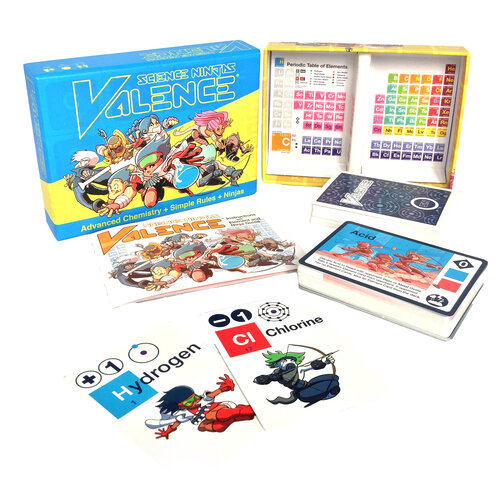The Science Ninjas Valence® card game makes it fun to learn about valences and combinations of elements. The cartoon-style artwork is based on a Ninja theme to appeal to students about ages eight and above.
The game itself is both educational and fun to play. It comes in a sturdy box and consists of two card decks and an instruction manual. Along with rules for playing the game, the instruction manual includes information about valences and the backstories of the Ninja characters.
One card deck has element cards, using the elements up through calcium on the periodic table. The other card deck has eight types of molecules that can be made with the element cards: acid, base, water, salt, carbon dioxide, metal oxide, “deadly” carbonyl, and halocarbon. To make it easier for players, the cards are color-coded. In the image for the game, you should be able to see a blue square on the hydrogen card and a red square on the chlorine card. The acid molecule card shows the corresponding colored squares for the required elements, so it’s fairly easy for players to match up the correct ones. However, players will sometimes combine several cards to make a molecule rather than just two. For instance, the water molecule requires one oxygen card (with a -2 charge) and two hydrogen cards (each with a +1 charge).
The back of each molecule card lists one or more different molecules that can be made for the molecular family. While water and carbon dioxide are the only molecules possible for those two cards, the other molecule cards list up to seven different molecules (for salts) that can be constructed with different combinations of elements. For example, for the base molecule card, players combine the correct number of sodium, oxygen, potassium, hydrogen, and calcium cards to make sodium hydroxide (NaOH), potassium hydroxide (KOH), and calcium hydroxide [Ca(OH)2]. The element cards clearly show their charges, and students can easily do the math to create molecules with balanced charges.
The molecule cards have different values ranging from 0 for acids to 6 for halocarbons. The goal of the game is to acquire molecules worth a total of ten points. It’s tougher than it sounds since other players can use their molecule cards to “react” with most of yours. You might have acquired a deadly carbonyl molecule card (worth 5 points), but an opponent attacks it with a water molecule card. Your deadly carbonyl is exchanged for a lower-value carbon dioxide card and an acid card. Some molecules, such as halocarbons, are stable, so they are immune to attack.
The game can be played in 20 minutes or less by two to four players.
Summary
The Science Ninjas Valence game is one of the rare educational games I’ve reviewed that is fun to play aside from its educational value.









